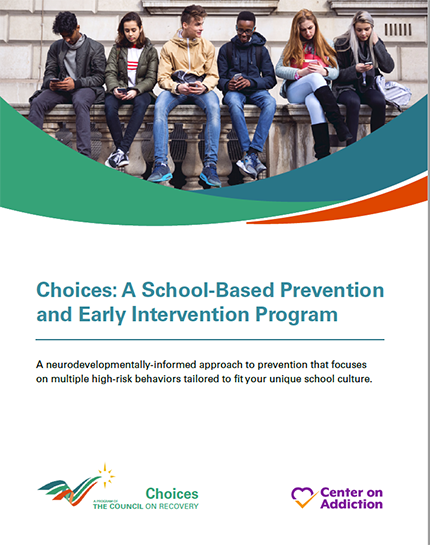Houston’s Council on Recovery’s Choices School-Based Prevention Program
Challenge
The Council on Recovery is a nonprofit community organization in Houston, Texas providing prevention, education, treatment, and recovery services related to substance use and co-occurring mental health disorders. The Council had developed and implemented a school-based prevention and early intervention program called Choices, which targeted 15 high-risk behaviors, including substance use, among adolescents. The program had three primary components: (1) Annual school survey to identify the prevalence and severity of risk factors, data from which were used to tailor program delivery at each school; (2) Universal psychoeducation about substance use and related risk factors; (3) Selected individual and small-group interventions provided by school counselors and Choices staff to youth at heightened risk. While the program held promise, it was not manualized or evaluated for effectiveness.
What we did
Partnership to End Addiction (then called Center on Addiction) staff – including Linda Richter, PhD, our current Senior Vice President of Prevention Research and Analysis, Cori Hammond, MPH, our current Director of Prevention Services, and Sarah Dauber, Ph.D., our current Vice President of Research and Evaluation – worked with the leadership of the Choices program and with the Council on Recovery to provide technical assistance in developing and conducting a feasibility evaluation for a Choices program manual; Choices training and quality assurance procedures; and Choices fidelity evaluation procedures. The goal of our work was to standardize the Choices program and prepare it for the rigorous testing that is required to measure outcomes and be recognized as “evidence based.” Work on the project proceeded in a highly collaborative manner our staff making multiple site visits to observe Choices program implementation and conduct interviews and focus groups with stakeholders.
Outcome
The pilot evaluation planning proceeded alongside the development of the standardized materials and outcome measurement tools. The pilot evaluation produced both quantitative and qualitative data that our staff analyzed and synthesized in a final report for The Council. We also provided The Council with a blueprint plan for a full-scale program evaluation that incorporated the results from the pilot and offered related adjustments to the Choices logic model. This blueprint plan included options of experimental design and methodology to meet different demands for internal and external validity as well as suggested outcome assessments and measures. The Council was able to utilize our expertise as they reevaluated their implementation model and thought through a more tailored and flexible program design.

